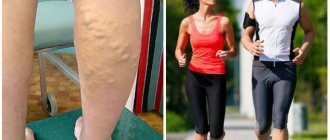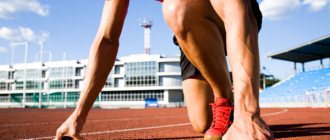During intense sports activities, some people develop heart problems. Tachycardia and sport are not entirely compatible concepts, since playing professional sports increases the heart rate and can cause a deterioration in well-being. However, moderate exercise is necessary to maintain fitness and improve health.
The benefits of sports for the body
Physical activity is the key to health. Physically active people get sick less often because their immune system is resistant to viruses. Such people cope better with stressful situations, and they rarely have problems associated with excess weight. During exercise, endorphins are produced, which has a beneficial effect on the nervous and cardiovascular systems. This helps increase endurance, lower blood cholesterol levels and reduce the risk of bronchopulmonary and colds.
Moderate exercise reduces the risk of developing varicose veins. The blood that circulates throughout the body, including the smallest vessels, delivers the necessary elements and oxygen to the organs. The circulatory system becomes more stable, and the elasticity of blood vessels improves. In addition, sport develops willpower.
Professional participation in heavy and too intense sports can undermine your health. Excessive stress causes premature wear of many organs and joints. The heart is no exception. When training, he needs a large amount of oxygen, the heart muscle contracts more quickly, which contributes to rapid wear of the myocardium.
Is exercise possible with tachycardia?
The normal heart rate in adults is 60-100 beats per minute. With tachycardia, this figure exceeds the norm. Professional sports activities help to increase your heart rate. As a result, blood circulation is disrupted, the body experiences a lack of oxygen, resulting in such unpleasant consequences as:
- increased heart rate;
- dyspnea;
- dizziness;
- fainting state.
A rapid heartbeat at rest may be a sign of a serious illness. Therefore, if such phenomena occur, you should definitely consult a doctor. The doctor will order an examination and determine the cause of the rapid heartbeat. Intense sports with tachycardia and running are contraindicated. However, gentle physical activity helps improve your condition and improve your health.
The easiest way is walking. You need to walk evenly, leisurely and at a comfortable pace. Walking helps strengthen the heart muscle. For tachycardia, exercise therapy is beneficial. The doctor develops a physical therapy program individually, taking into account the characteristics of the patient’s condition. You can play sports with tachycardia in the following forms:
- morning work-out;
- breathing exercises;
- water procedures.
For tachycardia, the following sports are recommended:
Relaxing bike rides are fun. Cycling provides moderate cardio exercise and relieves tension in the nervous system. As a result, the heart muscle is strengthened, vascular tone is increased, cholesterol levels are reduced, and the blood is enriched with essential nutrients and oxygen.
Therapeutic swimming
Water has a calming effect on humans. It has a beneficial effect on the central nervous system and provides a gentle massage effect on skin receptors and muscle nerves. This helps get rid of neurosis, which often causes tachycardia. Regular swimming normalizes the heart rate and has a positive effect on the respiratory system. Swimming during tachycardia is a good exercise for the muscles and a way to relax.
Skis and skates
These types of exercises bring great benefits to the body in the winter season. Moderate skiing or ice skating improves blood circulation. The vessels become wider, causing blood to move faster. Even with short walks, the heart rate gradually decreases. This has a positive effect on lung ventilation and promotes oxygen saturation in the blood. Regular skating helps cope with tachycardia and other heart ailments.
Other sports
Table tennis and volleyball contribute to improving heart condition and promoting health. These game exercises strengthen the musculoskeletal system, train the heart muscle, improve reaction, and develop discipline. Exercise therapy for heart diseases can be carried out in the form of physical exercises or on simulators. The gym with moderate loads is useful for a sedentary lifestyle. Yoga and Pilates are also helpful. These are static loads that train the body. Yoga is a good way to relieve stress, improve blood circulation and lower blood pressure.
Tachycardia and different sports
Tachycardia is a condition in which the heart beats at a rapid pace. The recognized norm for an adult is a pulsation of 60-80 beats per minute in a sitting position and up to 100 in a standing position. In children, the heart beats at a faster pace, and the number of heartbeats depends on age.
Read also: Tachycardia wiki
With tachycardia, too fast a heartbeat leads to disruption of blood circulation in the body. Insufficient oxygen in the blood causes shortness of breath, weakness, dizziness, darkening of the eyes and even fainting.
There is physiological tachycardia, that is, an increase in heart rate as a result of physical activity (for example, after running). It also occurs with severe anxiety, overeating and increased body or environmental temperature.
- All information on the site is for informational purposes only and is NOT a guide to action!
- can give you an ACCURATE DIAGNOSIS !
- We kindly ask you NOT to self-medicate, but to make an appointment with a specialist !
- Health to you and your loved ones!
This condition does not require treatment, unlike pathological tachycardia, which occurs at rest. It is an increased heart rate for no apparent reason that is a reason to consult a cardiologist.
And although it is known that an active lifestyle is beneficial for the heart, its safety during tachycardia is questioned by many. Let's figure out what physical activity is acceptable for people in this condition.
Arrhythmia: how does it occur?
Like the conductor of a symphony orchestra who synchronizes sounds into a single melody, the pacemaker, by sending electrical signals to the heart, synchronizes the muscle activity that leads to heart contractions. In order for the heart to function effectively and efficiently, the electrical system must work in a specific way. The heart's electrical system is a complex system of nerve pathways in highly specialized tissue that allows for efficient electrical conduction. Patients with arrhythmias often have additional, abnormal electrical connections within which impulses are generated.
Therefore, arrhythmia may occur when the electrical system uses these auxiliary connections. Instead of the heart beating at its normal speed, these extra electrical connections can cause the heart rate to spike (an arrhythmia). As a result, a speed is observed that exceeds the normal contractility of the heart several times - tachycardia. When this type of arrhythmia occurs, patients will experience a rapid and uncomfortable increase in heart rate, called palpitations.
Professional loads
Contrary to the popular belief that sport means health, the stress experienced by professional athletes quickly wears out their body and negatively affects their well-being.
In pursuit of the coveted medal, future champions are ready to mercilessly expend their strength, overexert their muscles, without giving them time to fully recover. It is clear that under such loads the heart muscle also suffers.
Here are a few reasons why intense exercise with tachycardia is contraindicated:
- with increased physical activity, the pulse quickens, and the number of heart contractions, which are already exceeded during tachycardia, increases;
- the desire to win leads to stress and the release of large amounts of adrenaline, which also speeds up the heart rate;
- regular lack of sleep before competitions negatively affects the entire body;
- there is a need for an additional influx of oxygen (in sprinters, for example, the volume of inhaled air increases 2-3 times), and intense breathing speeds up the heartbeat.
The answer to the question of whether it is possible to play sports with tachycardia becomes obvious if you notice that athletes undergo a medical examination twice a year, and if their heart rate accelerates, they are removed from activities.
Professional stress with an increased heart rate can lead to a heart attack, stroke, rupture of the organ itself or vital vessels
The impact of tachycardia on health
Not all types of heart palpitations are considered abnormal and have a negative impact on your health. The heart can sometimes generate extra single beats, causing an unusual sensation (extrasystole). With few exceptions, these occasional extra contractions are considered normal and do not affect overall health. However, a patient who experiences a sudden change in heart rate, severe tachycardia, requires further evaluation. Palpitations in such situations have a negative impact on health and can often be accompanied by discomfort, chest pain, dizziness or even loss of consciousness. These important symptoms are markers that the patient's heartbeat is a pathological arrhythmia and a detailed diagnosis is necessary.
Permitted species
However, some sports have a beneficial effect on the heart.
The following types of physical activity, combining moderate exercise and rest, are recommended by cardiologists:
Running and tachycardia
The question of whether you can run cannot be answered unequivocally. Of course, running at a fast pace is dangerous for heart health. At the same time, leisurely jogging with rest breaks can have a positive effect on health. However, it is not recommended to start running right away, especially after a long rest.
In the beginning, start by walking at a comfortable pace for you and gradually, day by day, speed up the pace. It is necessary to monitor your heart rate and monitor your general well-being, avoiding overexertion. Only in this case will running have a beneficial effect on the body.
But before you decide on any sport, you should be examined by a doctor. Tachycardia is not a disease in itself, but it can be a symptom of a serious illness in which even light exertion can be dangerous.
The impact of tachycardia on health
Not all types of heart palpitations are considered abnormal and have a negative impact on your health. The heart can sometimes generate extra single beats, causing an unusual sensation (extrasystole). With few exceptions, these occasional extra contractions are considered normal and do not affect overall health. However, a patient who experiences a sudden change in heart rate, severe tachycardia, requires further evaluation. Palpitations in such situations have a negative impact on health and can often be accompanied by discomfort, chest pain, dizziness or even loss of consciousness. These important symptoms are markers that the patient's heartbeat is a pathological arrhythmia and a detailed diagnosis is necessary.
Recommended sports activities for tachycardia
The most recommended types of physical activity for tachycardia are exercise and physical therapy.
Morning exercises awaken the body well and fill it with energy. 20 minutes of exercise will be enough to feel energized and active throughout the day. Exercises may include statistical exercises that will help develop coordination and proper breathing.
For those who do not like to get up early in the morning, you can do evening stretching exercises. Just 15-20 minutes of such activities will allow you to relax well and get ready for sleep. The main thing is to warm up your muscles well before such exercises to prevent sprains.
The causes of cardiac tachycardia in adults are described in this article.
Exercise therapy classes are carried out under the supervision of a doctor or qualified trainer. They form a special system of exercises aimed at improving health, so they are perfect for tachycardia.
It will be useful to include bending, breath-holding exercises, exercises for speed and muscle relaxation in your training.
For sinus arrhythmia
Sinus tachycardia is a rapid heart rate above 90 beats per minute (for adults), in which the correct heart rhythm is maintained. The contraction impulse comes from the sinus node.
This condition in itself is not a contraindication to sports. However, the loads for sinus tachycardia should not be excessive, and exercises should be performed regularly, then the heart muscle will strengthen, and the problem may disappear on its own.
To choose the right sport, it is worth finding out what disease is causing it. In some cases, this condition has only a psychological cause, and then autogenic training in combination with physical activity is simply necessary.
Arrhythmia: how does it occur?
Like the conductor of a symphony orchestra who synchronizes sounds into a single melody, the pacemaker, by sending electrical signals to the heart, synchronizes the muscle activity that leads to heart contractions. In order for the heart to function effectively and efficiently, the electrical system must work in a specific way. The heart's electrical system is a complex system of nerve pathways in highly specialized tissue that allows for efficient electrical conduction. Patients with arrhythmias often have additional, abnormal electrical connections within which impulses are generated.
Therefore, arrhythmia may occur when the electrical system uses these auxiliary connections. Instead of the heart beating at its normal speed, these extra electrical connections can cause the heart rate to spike (an arrhythmia). As a result, a speed is observed that exceeds the normal contractility of the heart several times - tachycardia. When this type of arrhythmia occurs, patients will experience a rapid and uncomfortable increase in heart rate, called palpitations.
Physical training
In order for physical education to benefit core patients, you should adhere to the following rules:
- start exercises with a short warm-up (for example, 20 squats, 2 minutes of jumping rope and a few push-ups), which will prepare the body for subsequent work;
- exercise no more than 4 times a week;
- training should last no more than 1-1.5 hours;
- exercise in comfortable and loose clothing;
- every 20-30 minutes take a break for 5 minutes to restore breathing;
- monitor the duration of night sleep - it should last at least 8 hours.
Read also: Nitroglycerin for tachycardia
With tachycardia, it is also useful to often be in the fresh air, perform breathing exercises and take water procedures. Simple finger pressure on the eyeballs can also bring cardiac activity back to normal.
The safest way to improve your physical condition is to walk at a leisurely pace. The duration of the walks is selected individually, but a leisurely evening promenade of 30-40 minutes would be optimal.
Regular movement will strengthen the heart muscle and, perhaps, after a while you will forget about what a rapid pulse is.
A useful and accessible exercise would be to simply climb the stairs. It is not necessary to completely abandon the elevator; to begin with, it is enough to climb 1-2 floors, and then gradually and carefully add the number of steps walked.
Fitness classes, dancing and aerobics, as well as lifting weights, are undesirable for tachycardia, as they require intense muscle work
This is one of the most harmless sports for heart palpitations. Regular yoga classes can even be healing and can establish a normal heart rhythm, improve your general condition and have a beneficial effect on the psyche.
A special study was conducted in which volunteers suffering from paroxysmal tachycardia (rapid heartbeat that occurs suddenly, in the form of an attack, and just as abruptly ends), had to do yoga twice a week. Meanwhile, scientists observed the course of tachycardia and were interested in the sensations of the participants.
It turned out that the number of fibrillations (scattered contractions of the muscle fibers of the heart that disrupt its functioning) decreased, and the emotional state and well-being of the participants improved. Volunteers also noted that heart rhythm disturbances occurred much less frequently.
However, there are some asanas that can speed up your heart rate, and therefore you should consult your doctor before practicing yoga.
Treatment methods for supraventricular tachycardia are described in this article.
Treatment of tachycardia with folk remedies for high blood pressure is described here.
Thus, physical activity during tachycardia is not only possible, but also useful, as it contributes to elation, a surge of strength and strengthening of the entire body.
Only professional sports are unacceptable, since it uses all human resources and excessively increases the heart rate. In any case, it is necessary to establish the cause of this condition and undergo a course of treatment. Then serious loads will be completely surmountable for you.
Permissible physical activity for cardiac arrhythmia
In order to benefit from physical exercise if you have any type of arrhythmia, you must consult a cardiologist and
diagnostic tests. These include:
- ECG in monitoring mode;
- stress test on a treadmill or bicycle ergometer;
- Ultrasound and echocardiography of the heart (if indicated).
Using these methods, you can determine the possible level of stress and its tolerance, the maximum heart rate at which you can train, and the risk of complications.
If the patient has not previously exercised, then exercise should begin with walking and gradually increase in duration and pace. In particularly difficult situations, the first stage may be breathing exercises and simple exercises, walking in place. The main rules for patients with arrhythmia are a slow pace, smooth movements and regular activity.
The most useful types of physical activity for heart rhythm disturbances:
- walking;
- physiotherapy;
- yoga;
- Pilates;
- swimming.
In the future, when the condition normalizes and in agreement with the attending physician, light running, cycling, dancing, and sports games can be added.
Not indicated in the presence of rhythm disturbances, training with weights, jumping, wrestling, static exercises, participation in competitions.
Are sports allowed with tachycardia?
After visiting a cardiologist and identifying pathology, people suffering from tachycardia do not stop exercising. Moreover, some sports help strengthen the cardiovascular system and keep the body in good shape. Among the most popular activities: swimming, cycling, team games, skiing and skating, walking and jogging.
Water activities not only strengthen the back muscles, but also have a beneficial effect on eliminating the symptoms of many diseases:
- Exercises in water calm the nervous system. The smooth massage effect of water on the skin, its comfortable temperature and horizontal position of the body helps fight neurosis, one of the causes of rapid heartbeat.
- Rhythmic muscle movement and uniform breathing are beneficial for the heart and blood vessels. Water pressure on the body normalizes the functioning of the heart muscles, increases the lumen of blood vessels and accelerates blood flow. With regular visits to the pool, the pulse decreases and normalizes, remaining at 55 beats per minute, because... the heart works more efficiently and powerfully.
- By systematically holding your breath, the lungs are trained and ventilated, the volume of air in them increases, and the blood is better enriched with oxygen.
If you replace professional exhausting races with cycling without standards, you can achieve no less positive effect than from swimming. Moderate cardiac stress, breathing training and positive emotions strengthen the heart and increase tone.
Skiing and skating
A great alternative to cycling is skiing. They usually take place in parks and forests in the fresh frosty air. Skiing and walking help improve blood flow both in large vessels and in the periphery in capillaries, blood flow accelerates, and blood pressure normalizes. The heart contracts more powerfully, without an idle increase in heart rate. People with tachycardia experience a decrease in heart rate to 65 beats per minute. Amateur skiing is recommended for all people with diseases of the cardiovascular system.
Game sports
Volleyball, pioneer ball - games to improve mood and strengthen the musculoskeletal system. There is an improvement in cardiac activity and muscle strengthening. Table tennis and billiards are also useful for tachycardia. Team exercises have a beneficial effect on a person’s reaction, discipline, responsibility and help cope with uncertainty and complexes, which usually lead to stress and rapid heartbeat. During such games, all muscle groups are alternately loaded, and respiratory functions and vascular function improve.
Read also: Orthodromic tachycardia
Walking and running
An important part of the treatment of heart disease is daily walking at a moderate pace for 35-45 minutes.
But the need for running during tachycardia is very controversial: during exercise, disturbances in the functioning of the heart can occur, leading to a surge in pressure, shortness of breath, and in severe forms of the disease - cardiac arrest. Therefore, running is allowed only in the form of a relaxed jog with frequent stops to normalize breathing. The patient should gradually add short runs to walking, increasing the pace and duration with each session. Cardiologists do not recommend jogging more than every other day.
Cardio training
Physical therapy (physical therapy) is not only a preventive measure for tachycardia, but also a means of therapy for the recovery of patients after a heart attack. The training is carried out on special simulators, and in their absence - like morning exercises. During consultation with cardiologists, it is necessary to select a set of exercises and frequency of training depending on the severity of the disease and the general health of the patient.
To prevent the occurrence of cardiovascular diseases, such exercise is recommended for all people with sedentary and sedentary work, regardless of age. For visitors to fitness clubs, it is recommended to carry out training under the supervision of a trainer to ensure proper execution and control of the load on the body. You can conduct classes independently with a heart rate monitor.
Yoga classes are classified as static fitness exercises. Such exercises are ideal for patients with nervous work and a disordered nervous system. During exercise, a balance is achieved between the body's physical tone and mental tone. Stressful tension is eliminated, the attitude towards situations and life improves, neurosis goes away, mood and motivation improve. Blood circulation accelerates, blood pressure returns to normal.
Yoga is especially beneficial for heart patients:
- there is a decrease in blood cholesterol levels;
- blood is enriched with oxygen;
- immunity and general tone of the body increases.
The main practice of yoga is breath control. Thanks to it, you can reduce your heart rate during exercise. Currently, yoga is indicated as part of therapeutic therapy for tachycardia.
Other physical activities
In the life of every person, there are other types of physical activity that can become both a means of preventing tachycardia and a cause of increased symptoms. Such loads include house cleaning, gardening, visiting a steam room, and having sex. If you experience any pain or deterioration in health, you must stop activity and allow yourself to catch your breath. If the condition worsens again, it is necessary to conduct an examination and begin treatment under the supervision of a doctor.
How to exercise correctly with tachycardia?
Following several recommendations will help protect the body from negative reactions during sports:
- Do a warm-up. Several exercises at a calm pace will help prepare the cardiovascular system for stress: 20 squats, 10 push-ups and jumping rope for 3 minutes.
- Choosing a loose suit. Tight-fitting clothing can impair blood flow to the extremities and make it difficult to fully perform exercises. Shorts or loose-fitting pants and a T-shirt of the appropriate size are the best option for sports.
- Time limit. Even with safe loads, it is worth limiting the workout to an hour and a half and taking a rest break. If you feel worse, stop exercising, and reduce subsequent sessions and increase the duration gradually.
- Frequency. Daily exercise is contraindicated for patients with tachycardia. It is optimal to conduct classes 3-4 times a week.
- Take breaks. To eliminate the symptoms of overload, you need to take short 3-5 minute breaks every 20 minutes to restore breathing.
- Maintain a sleep schedule. People with heart disease should not reduce their sleep below 7-8 hours per day. For a comfortable rest, you need to choose a comfortable pillow and, if possible, an orthopedic mattress.










